Urban design considerations for the area around Washington Nationals Baseball Stadium in advance of the 2018 All-Star Game
The current controversy over the name of the gateway to Fenway Stadium, Yawkey Way ("The Red Sox, the Confederacy, and Changing the Name of Yawkey Way," The Nation) in Boston, reminds me that since this past April's opening day for the Washington Nationals baseball team, I 've been meaning to write about the urban design-placemaking aspects of the area around the Stadium in Southeast Washington.
Now, I don't think the All Star Game will be a major moneymaker the way that touts claim ("The 2018 MLB All-Star Game could bring $100 million to D.C., economists say," Washington Post) as most of the revenues will be absorbed by Major League Baseball and travel and hotel companies, with little money remaining to be recirculated around the city.
But I do think it will be a great marketing opportunity for the area around the stadium--Capitol Riverfront and the Navy Yard District in Southeast, and the new Wharf District development on the Washington Channel in the adjacent Southwest quadrant--the development will be opening this fall.
Plus, regardless of the microeconomic impact, the All Star Game will bring tons of attention to DC, and why shouldn't we ensure that this attention shows the city in the best possible light?--especially the "local city" as opposed to the narrative of the city as the national seat of government, a reputation which is now deeply negative.
Unfortunately, the development of Half Street SE, the gateway into the Stadium from M Street SE and the Navy Yard Metrorail Station, is many years behind what was planned, as a result of 2008's Great Recession, which delayed by many years work on properties in this area.
Today the entryway into the stadium is sub-par and grim.

Although major buildings are under construction on N Street--the street in front of the stadium--and on Half Street, but it's unlikely that the ground plane of the buildings has been designed to be more like streetfronts and streetscapes of old, as demonstrated by the building already extant, and housing an entrance to the Metrorail station.
According to a now out-of-print publication produced by the Downtown DC BID, the Principles of Quality Storefronts include:
- Display Bays Every 20 Feet
- Continuous Storefront Retail
- Sidewalk Merchandising
- Colorful Banners & Awnings
- Inviting Displays & Attractive Merchandising.
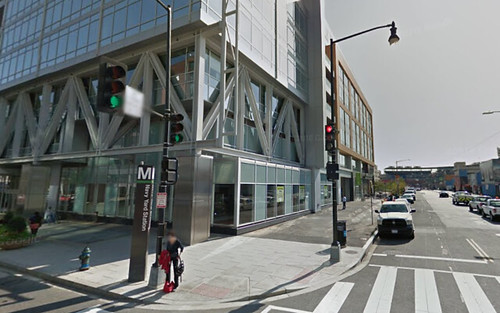
Building at the southeast corner of Half and M Streets SE. Google Street View image.
Office buildings tend to extend their façade design as a continuous wall from top to bottom without making special considerations for ground floor spaces intended for retail use. In these cases, the spacing of the storefronts, the size and design of the windows, and the height of the first floor tend to be out of sorts compared to expectations.
There should have been special urban design guidelines created for a "Stadium Special Design District," to ensure that the ground plane-built environment to be constructed on Half Street and N Street provided the best possible experience in terms of the Principles of Great Streets:
- Great Buildings & Storefronts
- Walkability
- Mixed Uses
- Great Food
- Great Stores
- Vibrancy & Sociability.
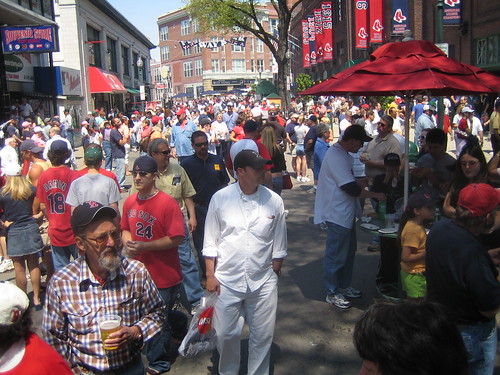
Flickr photo by Shawn Morrison who writes: They close off Yawkey Way before games now. It's like a carnival, bands playing all sorts of food and every variation on Red Sox clothing you could possibly imagine.
Half Street and N Street pale by comparison. Clearly, at this stage of development, the built environment side of the stadium is under-developed and fails to show off in positive ways its urban location.
Of course, the Baltimore Orioles stadium, Camden Yards, is another example, which ushered in the era of "throwback" stadium architecture.
While I would argue that that stadium's economic impact has been somewhat overstated based on the pace of revitalization in the West Side, as well as the lagging improvement of neighborhoods further west but within easy walking distance, the architecture and urban design principles exhibited in the final product have been top notch.
Similar to Yawkey Way, Eutaw Street along the stadium is pedestrianized and has the right scale and punctuation. It's not a streetwall of office buildings.
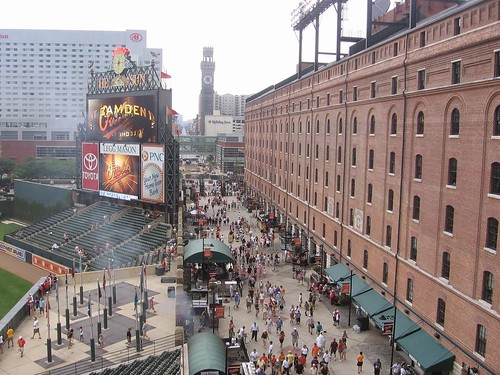
Pedestrianized Eutaw Street adjacent to Camden Yards. Photo by Klaus Philipsen, "Oriole Park at Camden Yards: Still the Model for Urban Ballparks.
Perhaps when the area around Nationals Stadium is finally "built out," DC will go back and redo the street treatments here, such as creating an in-street plaza comparable to that of Oxford Circus in London.
Note that my understanding is that there are plans to change the pavement materials of the street making it more plaza-like, maybe to make it function more like Yawkey Way on game days, where the street could be closed off to traffic.
Oxford Street, London, at Night.

Oxford Street Circus Intersection with Diagonal Crossings for Pedestrians. Image from E-Architect. Note that this street treatment was introduced in 2010, two years before London hosted the Olympics, and this timing was deliberate.
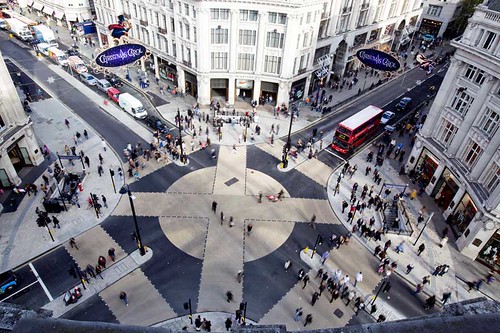
While it's not a direct example of the right kind of treatment for Half Street which ought to be termed "Nationals Way" now, Nashville's widening of sidewalks on Lower Broadway--a street with a great deal of pedestrian traffic--and the addition of bollards ("Nashville's Lower Broadway is getting a new look to improve safety along tourist thoroughfare," Nashville Tennessean) shows the kind of street treatment that ought to be happening on Half Street SE as a gateway to the stadium.
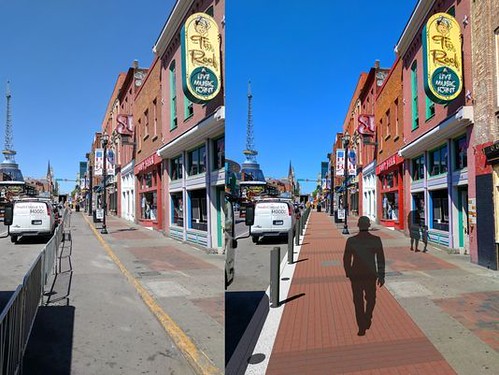
Before and after visualization of streetscape improvements to Lower Broadway, Nashville. Image: Nashville-Davidson County Planning.
Sadly, these kinds of improvements should have happened before the All-Star Game next year, just as London made a great many public space, street, and transit improvements in advance of the 2012 Olympics.
It's incredible that only this year have stakeholders started thinking more directly about preparing for the All-Star Game, based on this report, "Having taken measure in Miami, Nationals and D.C. now on the clock for 2018 All-Star Game," from the Washington Post. From the article:
It was a point that was not lost on any of the dozen or so Nationals employees scattered around Marlins Park for Tuesday night’s game, or the nearly 30 who had cycled in and out of Miami over the course of the past week to observe, take notes and otherwise learn the ins and outs of running one of baseball’s jewel events — which, more than a single baseball game, is a massive, week-long festival that stretches the resources of both the host ballpark and its city. The 2018 All-Star Game will be the fifth held in Washington but the first since 1969.It's too bad that the date wasn't shifted back a couple years, to 2019, 2020, or 2012, when the area around the Stadium is much likely to show better than it will next year.
“This is what we asked for,” said Gregory McCarthy, the Nationals’ vice president of community engagement. “This is what the team and [D.C. mayor Muriel E. Bowser] said to Major League Baseball: ‘We can do this.’ It’s a lot of work. But Washington does these events well. We do big events on this scale probably more than any other city.” ...
“For people who were involved in bringing baseball to D.C. 13 years ago, it’s another milestone for Washington being validated as a great sports town,” McCarthy said. “What’s neat about it all is, if you’re a die-hard baseball fan, you’ll find [the All-Star Game] to be a validating, enjoyable experience — for the experience and grandeur of the event, it’s the tops in the sport. But then, there are other events that appeal to the less-intense fans and people who aren’t baseball fans necessarily. That’s the great opportunity we see, the ability to get people from D.C. and the region from all persuasions engaged in all-star week.”
This is an example of how difficult it is to coordinate land use development actions by the public and private sectors for optimum results.
It definitely calls attention to the need for the creation of special design requirements in association with large projects and wide-scale redevelopment plans before the development starts, rather than long afterwards, when there are few opportunities to have impact even in the face of predictable sub-optimal outcomes.
Labels: commercial district revitalization planning, sports and economic development, stadiums/arenas, transportation planning, urban design/placemaking




4 Comments:
The comparison of an All-Star game to the Olympics seems to be of two completely different events. Not sure of the relevance.
I don't think it's fair to assume that local officials are only now beginning planning.
While it would be nice if the various buildings were finished for the game, timing is hard. Moving the game back a year isn't an option, these things are set well in advance.
As for Half Street:
- Half Street is a great name. "Nationals Way" is terrible. Almost as banal as "Nationals Park."
- Half Street is closed to traffic on game days, as is the 100 block of N Street (except for parking garage entries off of South Capitol Street). It's already functioning as a pedestrian only space; that function won't change once construction is finished. And yes, the actual street itself will be completely repaved when the construction is finished - the current asphalt is not the permanent design.
- There are special design guidelines for the area. The entire area is part of what was called the Capital Gateway overlay zone that requires mandatory design review before the zoning commission; the purposes of the review are specifically to encourage pedestrian use of Half Street during games.
http://www.dcregs.dc.gov/Gateway/ChapterHome.aspx?ChapterNumber=11-K5
- I'd note that the original Half Street renderings from Monument Realty included all sorts of lights strung overhead, but the zoning commission (and maybe some of the other federal review agencies) didn't like the potential impact of viewsheds.
- Eutaw street is a nice experience, but remember that it is part of the Stadium concourse on game days. You need a ticket to get in.
Of course it's not possible to set the time back for the All Stars game. My point was more, the Nationals should have been encouraged to wait a bit for bidding, til the buildings in the surrounding area were in line to "deliver." Too bad that didn't happen.
while I doubt the design guidelines will be that great in terms of effect (office building developers tend to have a problem creating distinctive retail-oriented ground planes but it's not out of the question), the point is that the experience should have been managed better, and it's not likely to be all that great for the All Star Game, and it could have been much better.
Yes, the street is closed for games. It's still grim. I doubt it will be re-conceptualized in time for the All Star Game.
It's not a huge deal. But it's something that ideally would have been done in a coordinated way to maximize the benefit.
... I hate to admit I've come around, some, on the "MCI Arena and the economic impact on Downtown generally and the east end specifically." The position you have been espousing for a long time.
I argued before it was partly timing. Even if that is the case, the importance of acceleration shouldn't be discounted. + the general benefits to the city in terms of marketing, as well as the local financial benefits vis a vis other communities within the region. (Not to mention the arena was privately financed, even if millions of public dollars were spent on infrastructure.)
And there is no question it accelerated the expansion and intensification of Downtown eastward, and improved the ec. climate for projects (like the freeway cap, which had been on the books for years, before the Verizon Center even existed) that were a stretch.
I think the point is that you can have simultaneously conflicting positions: (1) being against public funding (2) while still recognizing that the project will happen likely with public funding regardless of agitation and that since that is the case, focus on all those elements that are likely to maximize success.
That's what the framework in this post aims to do:
http://urbanplacesandspaces.blogspot.com/2014/03/an-arena-subsidy-project-id-probably.html
(3) while still aiming for better realization of some of the economic upside for the localities/stadium funders as a team's value increases.
https://www.washingtontimes.com/news/2017/jul/26/dc-mayor-muriel-bowser-insists-town-be-ready-2018-/
the street will be redone for 2020:
https://www.bizjournals.com/washington/news/2019/03/28/developers-plan-a-pedestrian-friendly-gateway-on.html
Post a Comment
<< Home